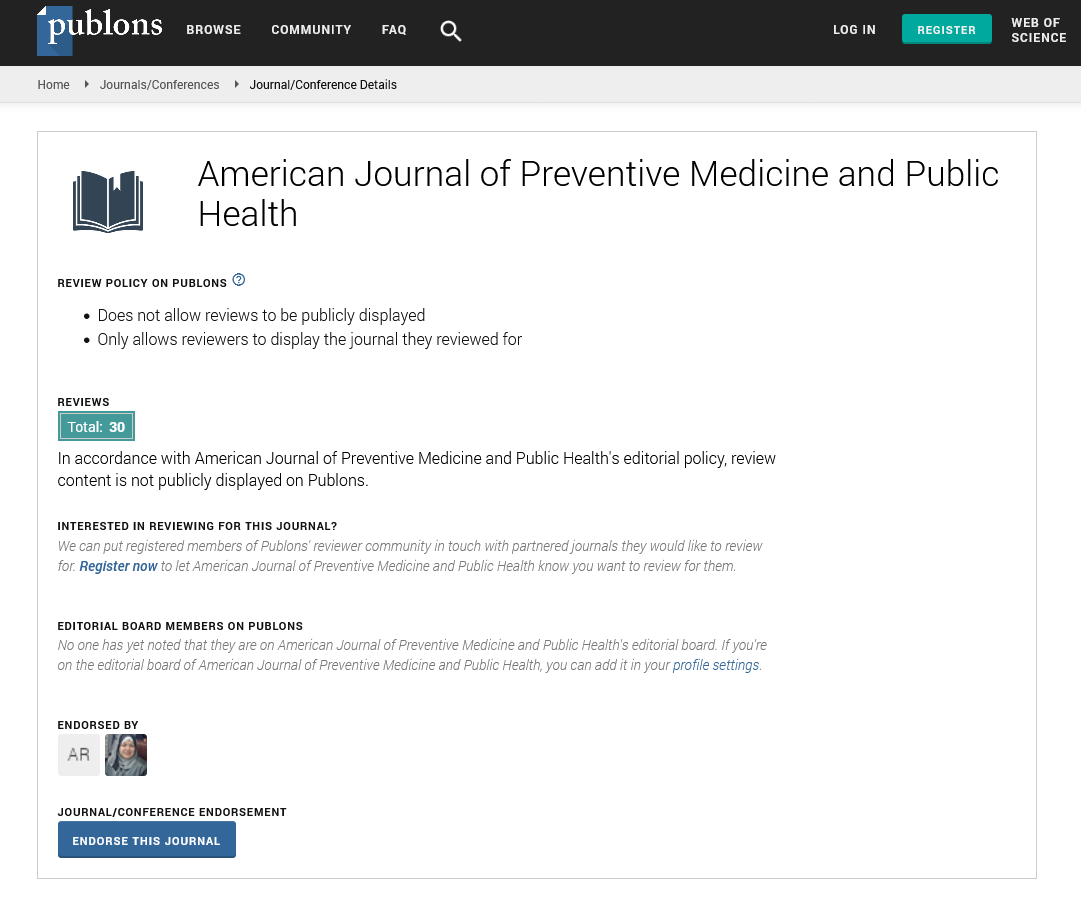Short Communication - American Journal of Preventive Medicine and Public Health (2022)
Age and Regional Differences in the Incidence of Heat-Related Ambulance Transport in Japan
Satoru Ueno1*, Daisuke Hayano2, Eiichi Noguchi3 and Tohru Aruga42Department of Emergency and Critical Care Medicine, Kanto Rosai Hospital, Japan Organization of Occupational Health and Safety, Kawasaki, Japan
3Department of Disaster Medicine, General Incorporated Association Toda Medical Group Headquarters, Yokohama, Japan
4Head Office, Japan Organization of Occupational Health and Safety, Kawasaki, Japan
Satoru Ueno, Work Environment Research Group, National Institute of Occupational Safety and Health, Japan Organization of Occupational Health and Safety, Kawasaki, Japan, Tel: +81-44-865-6111, Email: uenos@h.jniosh.johas.go.jp
Received: 17-Oct-2022, Manuscript No. AJPMPH-22-77455; Editor assigned: 19-Oct-2022, Pre QC No. AJPMPH-22-77455 (PQ); Reviewed: 04-Nov-2022, QC No. AJPMPH-22-77455; Revised: 10-Nov-2022, Manuscript No. AJPMPH-22-77455 (R); Published: 17-Nov-2022
Abstract
Heat waves are increasing in intensity, frequency and length due to climate change. In recent years, Tokyo has often had more than 10 days with a daily maximum temperature exceeding 35˚C. In 2020, Japan had 1,528 fatalities due to extreme heat exposure. Concurrently, populations are aging in many societies worldwide. In 2020, Japan’s percentage of the population aged 65 or older reached 28.6%. Much of the literature indicates that older people are physiologically and behaviorally less resistant to heat stress, resulting in age-related differences in the incidence of heat stroke. In addition to age, the difference in summer environmental conditions of a residential area may cause heterogeneity in the ability for local populations to adapt to extreme high temperatures.
Keywords
Heterogeneity; Environmental conditions; Physiological subject experiment; Acclimatization
Description
Our study examined the association between extreme temperatures and Heat-related Ambulance Transport (HAT) in terms of age and region [1]. The number of daily HAT, Daily Maximum Temperature (DMT), and Daily Maximum Wet Bulb Globe Temperature (DMW) were collected for all 47 prefectures in Japan from July 21st to August 31st in the years 2017 to 2020. Age categories were juveniles (7 to 17 years old), adults (18 to 64 years old) and elderly (65 years old or older). The total number of incidents examined was 178,357. The number of people transported by ambulance due to heat-related incidence per unit population per day was calculated for each degree of DMT or DMW for three age categories of 47 prefectures. The number of HAT increased almost exponentially with respect to DMT or DMW. By using the exponential relationships of regression curves, DMT (denoted as T1) or DMW (denoted as W1) when HAT is expected to occur for one in 100,000 people was calculated for three age categories and 47 prefectures. For 47 prefectures, T1 and W1 were plotted against DMT or DMW averaged during the period of the selected HAT data. The regression line relating T1 to average DMT of 47 prefectures was calculated for three age groups by least square weighted by the population of each prefecture. For regional difference, the highest average DMT was 34.4˚C in Kyoto and the lowest was 26.1˚C in Hokkaido. The highest, mean and lowest T1 in 47 prefectures were 35.4˚C, 33.0˚C and 30.5˚C for juveniles, 37.0˚C, 34.9˚C and 31.4˚C for adults, and 33.3˚C, 31.7˚C and 29.4˚C for elderly, respectively. A comparison at the same average DMT of 32.0˚C, T1 was 33.5˚C, 35.2˚C and 31.9˚C for juveniles, adults and elderly, respectively. Similarly, the highest average DMW was 31.3˚C in Nagasaki and the lowest was 24.0˚C in Hokkaido. The highest, mean and lowest W1 in 47 prefectures were 32.5˚C, 30.4˚C and 28.0˚C for juveniles, 33.5˚C, 31.8˚C and 28.7˚C for adults, and 30.8˚C, 29.4˚C and 26.9˚C for elderly. A comparison at the same average DMW of 30.0˚C, W1 was 31.1˚C, 32.4˚C and 29.8˚C for juveniles, adults and elderly, respectively.
Acclimatization occurs depending on the intensity or duration of environmental heat stress. In Japan, a physiological subject experiment observed that the human body becomes heat acclimatized by the natural summer heat environment [2]. Since Japan has a long north-south axis and average daily maximum temperatures in summer differed by more than 8°C, the heat acclimatization level is also expected to differ from prefecture to prefecture. In this study, T1, W1 were used as indicators of the local population’s susceptibility to heat stroke. Our analysis showed that T1 and W1 were lower in northern prefectures, indicating that residents in the north are less acclimatized to heat stress than those in the south. In the U.S., regional heat safety activity guidelines were made for each of three regions divided by warm season maximum WBGT [3]. In Ontario, Canada, three heat warnings were tailored to the differences in meteorological conditions and heat vulnerability identified across Extreme South-western, Southern, and Northern Ontario [4].
Conclusion
Regarding age differences, T1 was 3.3˚C higher in adults than in the elderly, indicating that heat stroke occurs at lower temperatures in the elderly. The benefit of our research is that the data analysis by age group corrects for discrepancies due to the different age structure of each prefecture, because both age and residence influence the occurrence of heat-related illness. The results of this study suggested that regional differences in summer temperatures and age should be taken into account for heat-related illness prevention planning.
Acknowledgment
None
Competiting Interests
None
References
- Ueno S, Hayano D, Noguchi E, Aruga T. Investigating age and regional effects on the relation between the incidence of heat-related ambulance transport and daily maximum temperature or WBGT. Environ Health Prev Med 2021; 24:116.
- Inoue Y, Nakao M, Okudaira S, Ueda H, Araki T. Seasonal variation in sweating responses of older and younger men. Eur J Appl Physiol Occup Physiol 1995; 70:6-12
[Crossref] [Google scholar][PubMed]
- Grundstein A, Williams C, PhanM. Regional heat safety thresholds for athletics in the contiguous United States. Appl Geogr. 2015; 56:55-60.
- Henderson D, Aubin L, Behan K, Chen H, Doyle H, Gower S et al. Developing a harmonized heat warning and information system for Ontario: a case study in collaboration. Can J Pub Health 2020; 111:426-32.
Copyright: © 2022 The Authors. This is an open access article under the terms of the Creative Commons Attribution NonCommercial ShareAlike 4.0 (https://creativecommons.org/licenses/by-nc-sa/4.0/). This is an open access article distributed under the terms of the Creative Commons Attribution License, which permits unrestricted use, distribution, and reproduction in any medium, provided the original work is properly cited.







